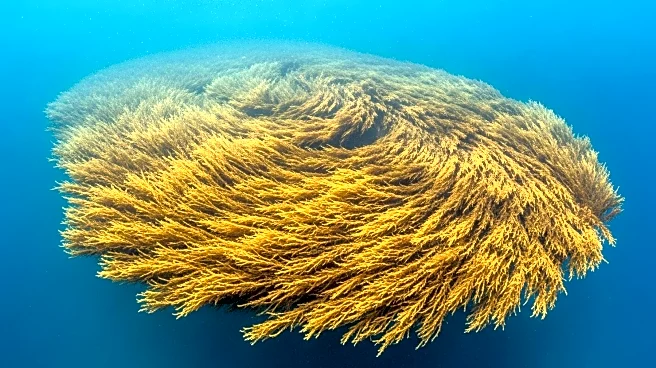What is the story about?
What's Happening?
A massive belt of brown algae known as sargassum has emerged in the Atlantic Ocean, stretching from the West African coast to the Gulf of Mexico. This phenomenon, once confined to the Sargasso Sea, has expanded dramatically, reaching lengths of up to 8,850 kilometers. Satellite images from May 2025 revealed 37.5 million tonnes of sargassum algae covering the Atlantic Ocean. The growth of this algae belt is linked to increased nutrient pollution from land, particularly nitrogen and phosphorus from agricultural runoff and wastewater discharge. The Amazon River contributes significantly to this nutrient load, especially during flood seasons. However, during droughts, the growth of sargassum slows, indicating the influence of weather patterns and climate variability.
Why It's Important?
The expansion of the sargassum belt poses significant ecological and economic challenges. Ecologically, while sargassum provides habitat for marine species, its excessive growth leads to harmful consequences, such as the release of toxic hydrogen sulfide gas when it decomposes. Economically, sargassum blooms disrupt tourism and fishing industries, as beaches become filled with rotting algae, creating unpleasant environments. Cleanup efforts are costly and labor-intensive, impacting local economies. The algae's decomposition also contributes to greenhouse gas emissions, raising concerns about its role in climate change. The spread of sargassum could lead to more frequent infrastructure shutdowns, as seen in 1991 when a nuclear power plant in Florida temporarily closed due to algae accumulation.
What's Next?
Scientists are closely monitoring ocean currents, such as the Gulf Stream and Loop Current, which transport sargassum across the Atlantic. These currents carry algae mats from the West African coast to the Gulf of Mexico, where they can accumulate in large clusters. The trajectory suggests that more regions could be impacted, not just along the Atlantic coast but globally. This phenomenon might signal broader oceanic changes, prompting further research into nutrient pollution and its effects on marine ecosystems. Coastal communities may need to develop strategies to mitigate the economic impact of sargassum blooms, including improved cleanup methods and infrastructure adaptations.
Beyond the Headlines
The rapid growth of sargassum highlights the intersection of human activities and ocean health. The nutrient enrichment from land-based sources underscores the need for sustainable agricultural practices and wastewater management to reduce pollution. The ecological role of sargassum as a habitat for marine life contrasts with its detrimental effects when overgrown, illustrating the delicate balance within marine ecosystems. The situation calls for international cooperation to address nutrient pollution and its global impact, as well as innovative solutions to manage sargassum blooms effectively.
AI Generated Content
Do you find this article useful?















